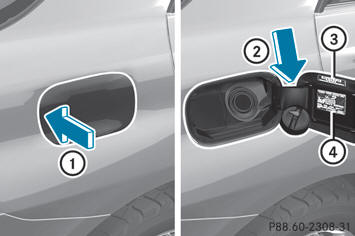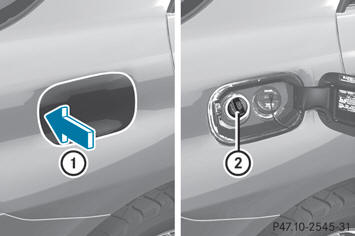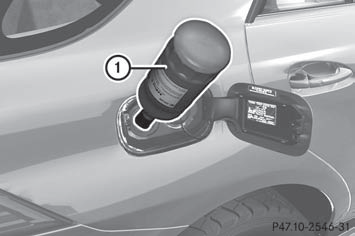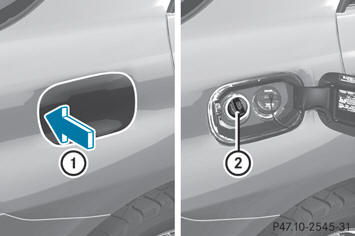Refueling
Important safety notes
 WARNING
WARNING
Gasoline and diesel fuels are highly flammable
and poisonous. They burn violently and can
cause serious injury.
Never allow sparks, flames or smoking materials near gasoline or diesel fuel!
Turn off the engine before refueling.
Whenever you are around gasoline or diesel fuel, avoid inhaling fumes and any skin or clothing contact. Extinguish all smoking materials.
Direct skin contact with fuels and the inhalation of fuel vapors are damaging your health.
 WARNING
WARNING
Overfilling of the fuel tank may create
pressure in the system which could cause a
gas discharge. This could cause the gasoline
to spray back out when removing the fuel
pump nozzle, which could cause personal
injury.
 WARNING
WARNING
Do not fill diesel tanks with gasoline. Do not
mix diesel fuel with gasoline. Otherwise the
fuel system and engine could be damaged. In
addition, the vehicle could catch fire.

Do not use gasoline to refuel vehicles with
a diesel engine. Do not use diesel to refuel
vehicles with a gasoline engine. Even a
small quantity of the wrong fuel will
damage the fuel system and engine.

Do not switch on the ignition if you
accidentally refuel with the wrong fuel.
Otherwise, the fuel will enter the fuel lines.
Notify a qualified specialist workshop and have the fuel tank and fuel lines drained completely.
Gasoline
Fuel grade

You should only refuel with premiumgrade
unleaded gasoline, as this avoids
damaging the catalytic converter.
Flexible fuel vehicles, identifiable from the label inside the fuel filler flap, can be refueled with E85. For further information on flexible fuel, see "Fuel".
If engine running problems are apparent, have the cause checked immediately and repaired. Excess unburned fuel can otherwise enter the catalytic converter, leading to overheating and possibly causing a fire.

Use a filter when refueling from a fuel can.
Otherwise, the fuel lines and/or injection system could be blocked by particles from the fuel can.

Only refuel with premium-grade unleaded
gasoline with a specified minimum octane
number of 91 (average value of 96 RON/86 MON).
You will usually find information about the fuel grade on the pump. If you cannot find the label on the pump, ask the staff for assistance.
You can find more information under "Fuel", or by contacting an authorized Mercedes-Benz Service Center or visiting http://www.mbusa.com (USA only).
Diesel
Fuel grade

Only refuel with ULTRA-LOW SULFUR
DIESEL FUEL (ULSD, 15 ppm SULFUR
MAXIMUM). Using other diesel fuels could
result in increased wear and damage to the
engine and/or exhaust system.
Never refuel with marine diesel or heating oil.
Do not mix these fuels with diesel fuels and do not use any special additives, as this may result in damage.

Use a filter when adding fuel from a fuel
can. Otherwise, the fuel lines and/or the
fuel injection system could be blocked by
particles from the fuel can.

Usually, you will find information about
the fuel grade on the pump. If you cannot
find the label on the gasoline pump, ask the
gas station staff.
You can find more information under “Fuel”, or by contacting an authorized Mercedes-Benz Service Center or visiting http://www.mbusa.com (USA only).
Low outside temperatures

Do not use gasoline to refuel vehicles with
a diesel engine. Never mix diesel with
gasoline or kerosene, as this may result in
damage to the engine or fuel system.
Diesel fuel with improved cold flow properties is available during the winter months. Further information on fuel properties can be obtained from oil companies, e.g. at gas stations.
Refueling
Fuel filler flap
The fuel filler flap is unlocked or locked automatically when you open or close the vehicle with the SmartKey or using KEYLESSGO.
The position of the fuel filler cap is displayed
in the instrument cluster  . The
. The
arrow
next to the filling pump indicates the side of
the vehicle.

1 To open the fuel filler flap
2 To insert the fuel filler cap
3 Fuel type
4 Tire pressure table
Opening
- Switch off the engine.
- Remove the SmartKey from the ignition lock.
KEYLESS-GO: open the driver’s door. This switches the ignition to position 0, which corresponds to having removed the SmartKey. The driver’s door can be closed again.
- Press the fuel filler flap in the direction of arrow 1.
The fuel filler flap swings up.
- Turn the fuel filler cap counter-clockwise and remove it.
- Insert the fuel filler cap into the holder bracket on the inside of filler flap 2.
- Completely insert the pump nozzle into the filler neck and refuel.
- Only fill the tank until the pump nozzle switches off.

Overfilling the fuel tank could damage the
fuel system.
Closing
- Replace the fuel filler cap and turn it clockwise. The fuel filler cap audibly engages.
- Close the fuel filler flap.

If you drive with the fuel filler cap open,
reserve fuel warning lamp  flashes.
flashes.
In
addition, the  Check Engine warning
Check Engine warning
lamp may light up. A message appears in
the multifunction display.
For further information on warning and indicator lamps in the instrument cluster.
Problems with fuel and the fuel tank
| Problem | Possible causes/consequences and
 Solutions Solutions |
| Fuel is leaking from the vehicle. | Risk of explosion or fire The fuel line or the fuel tank is defective. - Turn the SmartKey to position 0 in the ignition lock immediately and remove it. - Do not restart the engine under any circumstances. - Consult a qualified specialist workshop. |
| The fuel filler flap cannot be opened. | The fuel filler flap is not unlocked.
or - Unlock the vehicle.
or |
| The fuel filler flap is unlocked, but the opening mechanism is
jammed. - Consult a qualified specialist workshop. |
|
| The engine will not start. | The fuel tank of a vehicle with a diesel engine has been run
completely dry. - Refuel the vehicle with at least 5.3 US qt (5 liters) of diesel. - Turn the ignition on for at least 10 seconds. - Start the engine continuously for up to 10 seconds until it runs smoothly. If the engine does not start: - Turn the ignition on again for approximately 10 seconds. - Start the engine again continuously for up to 10 seconds until it runs smoothly. If the engine does not start after three attempts: - Consult a qualified specialist workshop. |
DEF
Important notes on use
To function properly, BlueTEC exhaust gas aftertreatment must be operated with the reducing agent DEF.
When the DEF supply has almost run out, the Check Additive See Operator's Manual message is shown in the multifunction display.
When the DEF supply sinks to a minimum level, the Remaining Starts: 16 message is shown in the multifunction display.
When the Remaining Starts: 16 message is shown in the multifunction display, you can start the engine 16 more times. If DEF is not added, it will not be possible to restart the engine. Fill the DEF tank with approx. 1 gal (3.8 l) DEF, or have it filled at a qualified specialist workshop.

If you drive the vehicle faster than 10 mph
(16 km/h), the Check Additive See
Operator's Manual message goes off
after approximately one minute.
Further information about BlueTEC exhaust gas aftertreatment and DEF is available at any authorized Mercedes-Benz Center.
Adding DEF
 WARNING
WARNING
Make sure
- DEF does not come into contact with skin, eyes, or clothing
- to keep DEF out of the reach of children
If you and/or others have come into contact with DEF:
- If DEF has gotten into contact with eyes, flush with plenty of water
immediately and seek medical help.
- Clean affected skin immediately with plenty of water.
- If DEF was swallowed, rinse mouth immediately with plenty of water and drink plenty of water. Consult a physician.
 WARNING
WARNING
If you open the DEF tank cap, small amounts
of ammonia vapor may be released. This
depends in particular upon the age of the DEF.
Ammonia vapors have a pungent odor and are particularly irritating to:
- skin
- mucous membranes
- eyes
You may experience a burning sensation in
your eyes, nose and throat, as well as
coughing and watering of the eyes.
Do not inhale any ammonia vapors that may be released. Fill the DEF tank only in wellventilated areas.

Only use DEF in accordance with
ISO 22241. Do not mix any additives with
DEF, and do not dilute DEF with water. This
may destroy the BlueTEC exhaust gas
aftertreatment system.

The vehicle must be parked on level
ground to fill the DEF tank. The DEF tank
can only be filled as intended with the
vehicle parked on a level surface. This
avoids false level readings. Filling the tank
is not permitted if the vehicle is not parked
on a level surface. There is a danger of
overfilling, which could result in damage to
components of the BlueTEC exhaust gas
aftertreatment.
If the outside temperature is lower than - 11 °C, damage may occur when adding DEF.
If DEF is frozen and there is an active warning indicator, adding may not be possible. Park the vehicle in a warmer place, e.g. in a garage, until DEF has become fluid again. Filling is then possible again. Alternatively, have the DEF tank refilled at a qualified specialist workshop.

Rinse surfaces that have come into
contact with DEF immediately with water or
remove DEF using a damp cloth and cold
water. If the DEF has already crystallized,
use a sponge and cold water to clean it. DEF
residues crystallize after time and
contaminate the affected surfaces.

DEF is not a fuel additive and must not be
added to the fuel tank. If DEF is added to
the fuel tank, this can lead to engine
damage.
Further information on DEF.
Opening the DEF filler cap
The filler neck for DEF is behind the fuel filler flap.
The fuel filler flap is unlocked or locked automatically when you open or close the vehicle with the SmartKey or with KEYLESSGO.

- Switch off the ignition.
- Press the fuel filler flap in the direction of arrow 1.
The fuel filler flap swings up.
- Turn blue DEF filler cap 2 counterclockwise and remove it.
DEF filler cap 2 is secured with a plastic strap.
DEF refill bottle
DEF refill bottles can be obtained at many gas stations or at an authorized Mercedes-Benz Center. Refill bottles without a threaded cap do not provide overfill protection. DEF may leak if overfilled. Mercedes Benz provides special refill bottles with threaded caps.
These are available at any authorized Mercedes-Benz Center.

- Unscrew the protective cap from DEF refill bottle 1.
- Place DEF refill bottle 1 on the filler neck as shown and screw it on clockwise until it is hand-tight.

Only screw on the DEF refill bottle handtight.
It could otherwise be damaged.
– Press DEF refill bottle 1 in the direction of the filler neck.
The DEF tank is filled. This may take up to one minute.

When DEF refill bottle 1 is no longer
pressed, filling stops and the bottle may be
taken off again after being only partially
emptied.
– Release DEF refill bottle 1.
– Turn DEF refill bottle 1 counterclockwise and remove it.
– Screw on the cover of DEF refill bottle 1 again.
Closing the DEF filler cap and fuel filler flap

– Place DEF filler cap 2 on the filler neck and turn it clockwise.
– To close the fuel filler flap, press it in the direction of arrow 1.
– Drive at a speed above 10 mph (16 km/h).
The Check Additive See Operator's Manual message disappears after approximately one minute.

If the Check Additive See
Operator's Manual message continues
to be shown in the multifunction display,
you need to add more DEF.
See also:
Vehicle data
Please note that for the specified vehicle
data:
- the heights specified may vary as a result
of:
- tires
- load
- condition of the suspension
- optional equipment
...
Reporting safety defects
USA only:
The following text is reproduced as required
of all manufacturers according to Title 49,
Code of U.S. Federal Regulations, Part 575
pursuant to the National Traffic and Motor
Vehicle Sa ...
Assistance menu
Introduction
In the DriveAssist menu, you have the
following options:
• showing the distance display
• activating/deactivating the distance
warning function
• activating/deactiva ...
